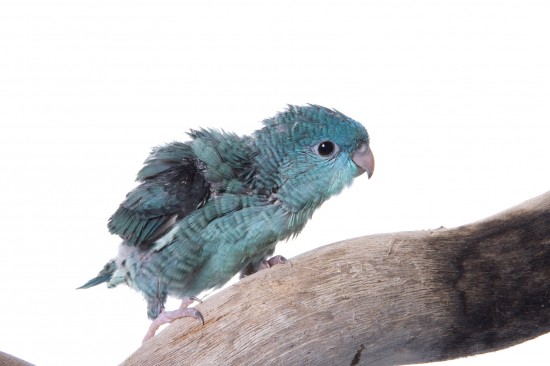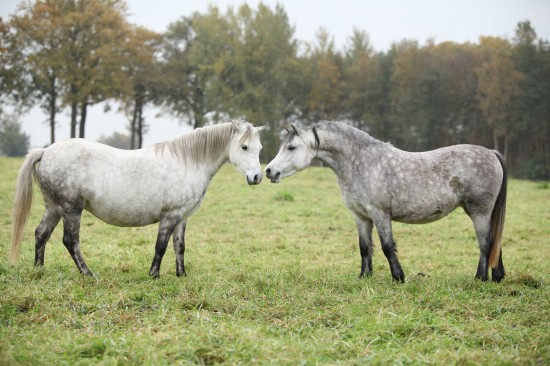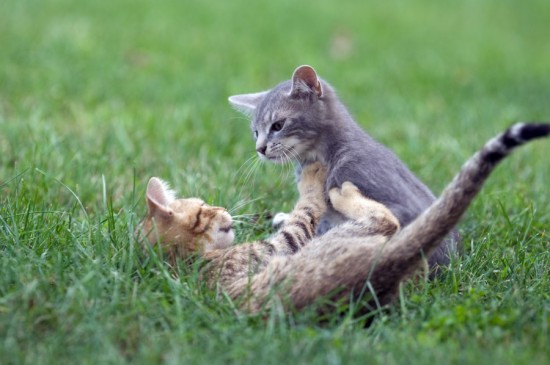
Most of us are familiar with a variety of cat sounds, including meows, hissing, growls and purrs. A meow can mean anything from “I want food” to “will you play with me?” to “hello there”. Some cats, such as Siamese cats, are much more vocal than others. No one knows exactly how the purring sound is made but it usually indicates contentment. Hissing and growling usually mean the cat feels threatened or unhappy about something. Cats, especially very young ones, might make these sounds when playing too.
Cats rarely meow when communicating amongst themselves. They use a combination of body language, tail movement, scent and eye contact. When communicating with humans, cats differ their sounds by rhythm, intensity, pitch, tone and volume, so we can take a reasonable guess at what they are trying to say.
Cats sometimes use sounds when communicating with one another too. If a kitten wanders off, the mother cat might meow loudly and clearly to call her offspring back to safety. A cat might hiss or growl if another cat or intrudes on its territory. A cat enjoying some prey it has hunted will also use these sounds to warn off another cat coming too close.
Cat Sense of Smell and Communication
A cat’s sense of smell is acute and highly developed. It is used in several ways to facilitate communication. Two cats living together will sniff each other several times a day. This tells the cats where the other has been, what they have been doing, what they have recently eaten and whether they came into contact with another animal. Cats detect pheromones left by other cats, usually when marking territory. If a cat could talk, it might ask these things verbally but a few sniffs tell them everything they need to know.
Cats living together often groom one another. This provides social interaction, removes parasites and keeps the fur clean. A mother cat recognises the scent of her own kittens and grooms them often to provide comfort, keep them clean and encourage bowel movements.
Cat Talk and Hierarchy
Hierarchy amongst cats is determined by the outcomes of social interactions between the cats. Some factors determining hierarchy include gender, the environment, reproductive status, age, size, aggressiveness and submissiveness.
Hierarchy between cats is different to hierarchy between dogs. Dogs are pack animals and exhibit dominant actions, such as growls, stares or body checks. Cats, on the other hand, don’t live or hunt in packs. If two or more cats live together, the hierarchy might be present but humans might not recognise the subtle dominance signals and cat secret talk is used to decide hierarchy. One sure-fire way to upset a hierarchy is to introduce a new cat. The newcomer’s status is unclear so the other cats will use their secret communication to sort the situation out.
Cat Communication and Territory
Cats are territorial animals. Their territory is usually a combination of places they share with other cats and other places they consider theirs and their alone. A cat marks its territory by urinating, scratching or rubbing its body on an object. Other cats can see these marks as clearly as signposts, telling them which other cat’s territory they are in. Cats can detect pheromones in urine or from a place where another cat has rubbed itself.
With so many ways of determining territory, hierarchy and much more, cats hardly need words!
What is Cat Secret Talk?
Most of us are familiar with a variety of cat sounds, including meows, hissing, growls and purrs. A meow can mean anything from “I want food” to “will you play with me?” to “hello there”. Some cats, such as Siamese cats, are much more vocal than others. No one knows exactly how the purring sound is made but it usually indicates contentment. Hissing and growling usually mean the cat feels threatened or unhappy about something. Cats, especially very young ones, might make these sounds when playing too.
Cats rarely meow when communicating amongst themselves. They use a combination of body language, tail movement, scent and eye contact. When communicating with humans, cats differ their sounds by rhythm, intensity, pitch, tone and volume, so we can take a reasonable guess at what they are trying to say.
Cats sometimes use sounds when communicating with one another too. If a kitten wanders off, the mother cat might meow loudly and clearly to call her offspring back to safety. A cat might hiss or growl if another cat or intrudes on its territory. A cat enjoying some prey it has hunted will also use these sounds to warn off another cat coming too close.
Cat Sense of Smell and Communication
A cat’s sense of smell is acute and highly developed. It is used in several ways to facilitate communication. Two cats living together will sniff each other several times a day. This tells the cats where the other has been, what they have been doing, what they have recently eaten and whether they came into contact with another animal. Cats detect pheromones left by other cats, usually when marking territory. If a cat could talk, it might ask these things verbally but a few sniffs tell them everything they need to know.
Cats living together often groom one another. This provides social interaction, removes parasites and keeps the fur clean. A mother cat recognises the scent of her own kittens and grooms them often to provide comfort, keep them clean and encourage bowel movements.
Cat Talk and Hierarchy
Hierarchy amongst cats is determined by the outcomes of social interactions between the cats. Some factors determining hierarchy include gender, the environment, reproductive status, age, size, aggressiveness and submissiveness.
Hierarchy between cats is different to hierarchy between dogs. Dogs are pack animals and exhibit dominant actions, such as growls, stares or body checks. Cats, on the other hand, don’t live or hunt in packs. If two or more cats live together, the hierarchy might be present but humans might not recognise the subtle dominance signals and cat secret talk is used to decide hierarchy. One sure-fire way to upset a hierarchy is to introduce a new cat. The newcomer’s status is unclear so the other cats will use their secret communication to sort the situation out.
Cat Communication and Territory
Cats are territorial animals. Their territory is usually a combination of places they share with other cats and other places they consider theirs and their alone. A cat marks its territory by urinating, scratching or rubbing its body on an object. Other cats can see these marks as clearly as signposts, telling them which other cat’s territory they are in. Cats can detect pheromones in urine or from a place where another cat has rubbed itself.
With so many ways of determining territory, hierarchy and much more, cats hardly need words!
kitties and how to save a marriage
 Facts About Pet Vaccinations You Need To Know
Facts About Pet Vaccinations You Need To Know
 Is The Coton De Tulear A Good Family Dog?
Is The Coton De Tulear A Good Family Dog?
 Ten Tips For Keeping Your Dog Calm And Comfortable On New Year’s Eve
Ten Tips For Keeping Your Dog Calm And Comfortable On New Year’s Eve
 The Lineolated Parakeet (linnies)
The Lineolated Parakeet (linnies)
 Top Tips When Walking Your Dog When Its Raining
Top Tips When Walking Your Dog When Its Raining
 What Dog Shelter Adoption Fees Cover, And Why They Are Charged
What Dog Shelter Adoption Fees Cover, And Why They Are Charged
 Is A Siamese Cat The Right Pet For You?
Is A Siamese Cat
Is A Siamese Cat The Right Pet For You?
Is A Siamese Cat
 The Cheeky Welsh Mountain Pony
The Cheeky Welsh
The Cheeky Welsh Mountain Pony
The Cheeky Welsh
 Cat-cat Aggression Within The Household
Cat-cat Aggressio
Cat-cat Aggression Within The Household
Cat-cat Aggressio
 Four Ways To Teach Your Dog Or Puppy Better Bite Inhibition
Four Ways To Teac
Four Ways To Teach Your Dog Or Puppy Better Bite Inhibition
Four Ways To Teac
 How Do Male Dogs Respond To The Addition Of A New Baby Into The Home?
How Do Male Dogs
How Do Male Dogs Respond To The Addition Of A New Baby Into The Home?
How Do Male Dogs
Copyright © 2005-2016 Pet Information All Rights Reserved
Contact us: www162date@outlook.com